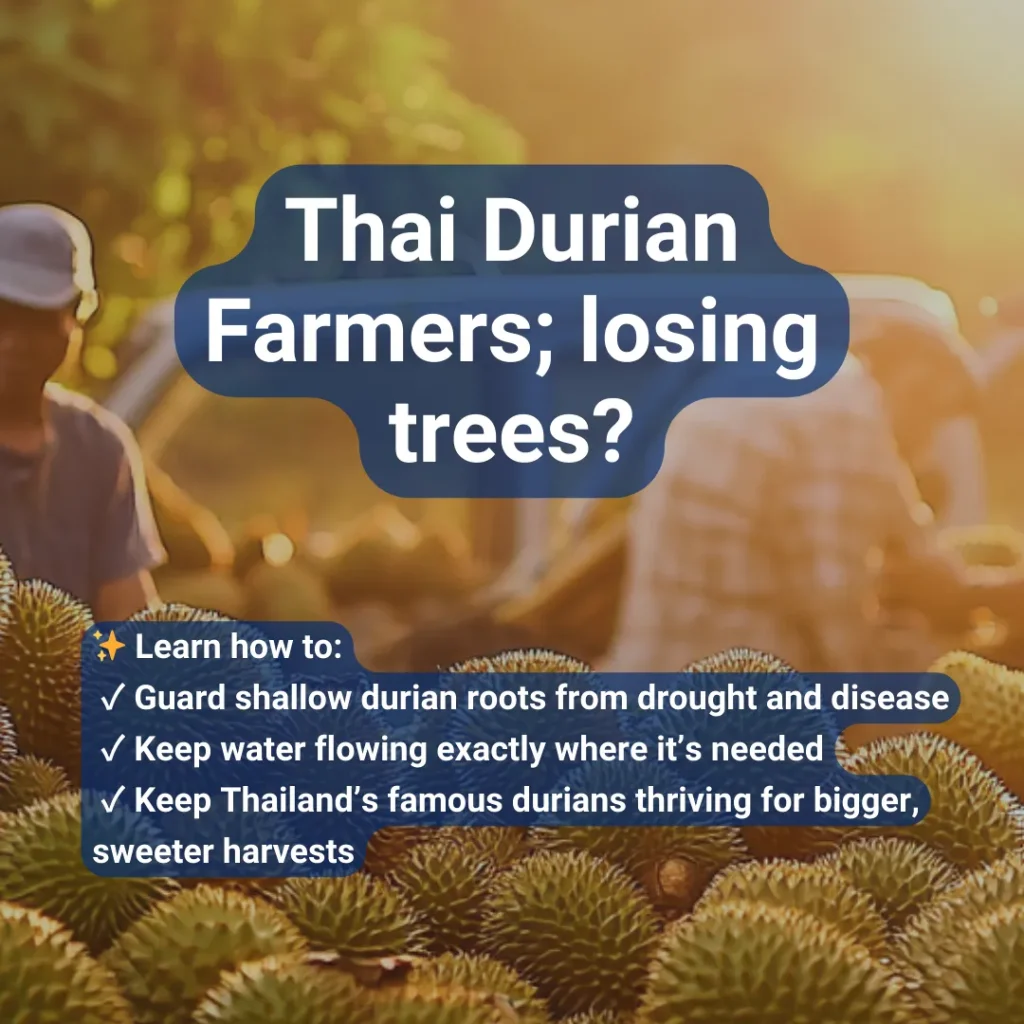Thailand is famous worldwide for producing some of the tastiest and most sought-after durians.
Thai durian farmers have proudly built a global reputation, with Thailand being the world’s largest exporter of durians.
Yet, recent years have become challenging.
Farmers across the country report smaller fruits, reduced sweetness, and declining overall yields, threatening their profits and Thailand’s leadership in the global durian market.
You might think pests, fertilisers, or diseases are the main issues—and they can certainly cause problems. But one major issue farmers often overlook is actually much simpler: their watering systems.
Specifically, outdated irrigation methods and unreliable rainfall are creating big problems for durian farmers.
Why Watering Has Become a Big Problem
Durian trees need very specific water conditions to thrive. Their roots grow shallow—only about 45 cm below the surface.
This means the trees need water consistently delivered directly to this shallow root zone. Too much water or too little water can quickly harm the trees, affecting fruit quality and quantity.
But recent climate conditions have made getting water right even harder.
The Impact of El Niño
Thailand’s weather has become increasingly unpredictable due to climate change and particularly the El Niño phenomenon. El Niño causes long drought periods, which severely disrupt normal watering cycles.
According to recent data, the El Niño drought of 2024 was devastating for Thailand’s durian orchards, causing a nationwide yield drop of around 18%—the largest decrease seen in over 15 years.
Durian trees facing drought conditions produce smaller fruits, reduce their sweetness, and ultimately result in lower market prices and profits.
This crisis isn’t a one-off event. Climate experts predict these unpredictable drought cycles are likely to continue, potentially worsening over time.
Traditional Methods Fail in Today’s Climate
Many Thai durian farmers still rely heavily on traditional watering methods such as flood irrigation or overhead sprinklers.
These methods might feel simple and cost-effective at first, but they’re actually causing more harm than good.
Flood irrigation and sprinklers distribute water unevenly across orchards.
Water pools in some areas, encouraging root diseases like root rot (Phytophthora).
Other areas dry out quickly, stressing trees and leading to inconsistent fruit growth and lower-quality durians.
Excess water encourages fungal infections, while drought stress leaves trees vulnerable to pests and disease outbreaks.
This traditional approach means that durian farmers often face the dual problem of water waste and increased disease risk.
In Indonesia, similar issues caused by erratic rainfall and broken irrigation systems have severely reduced farmers’ yields, according to local reports.
How Drip Irrigation Solves the Water Problem
The good news is there’s a clear and simple solution that many farmers have yet to adopt widely—precision drip irrigation.
Unlike flooding or sprinklers, drip irrigation delivers exact amounts of water and nutrients directly to the durian tree’s shallow roots.
Here’s why drip irrigation is a game changer:
- Exact Watering: Drip irrigation targets the shallow root zone, eliminating water waste.
- Consistent Water Supply: Regular drip irrigation reduces tree stress, enhancing fruit size and sweetness.
- Disease Prevention: By avoiding overly wet conditions, drip irrigation reduces the risk of fungal diseases significantly.
- Resource Efficiency: Farmers can reduce water usage by 20–50%, translating directly to lower costs and improved profits.
Real-world Proof from Farms in Southeast Asia
Farmers across Southeast Asia have already tested drip irrigation, achieving remarkable results documented by various research studies and reports:
- Malaysian farmers using drip irrigation saw yield improvements of up to 40% and labour costs reduced by nearly 30%.
- IoT-based drip irrigation systems in Malaysian durian orchards showed increased yield and healthier trees, even during drought.
- Drones and precision irrigation techniques used in Vietnam reduced labour costs by 60% and pesticide use by 70%.
Easy Steps for Thai Farmers to Implement Drip Irrigation
You might be thinking, “This sounds good, but is it practical for my orchard?” The answer is yes—and it’s easier than you think. Here’s how you can start making this beneficial change today:
- Assess Your Current Irrigation Setup:
- Check for signs of uneven watering or disease like yellow leaves, small fruits, or root rot symptoms.
- Get Expert Advice:
- Reach out to irrigation experts at Netafim and Jebsen & Jessen to plan a system tailored specifically to your orchard’s layout, soil type, and tree variety.
- Design a Custom Drip System:
- Netafim experts can help design a drip system to precisely deliver water to your trees’ shallow root zones.
- Install and Automate:
- Professional installation ensures water is precisely delivered. Automation keeps irrigation regular and stress-free.
- Monitor and Adjust:
- Regularly check your trees and soil moisture levels, adjusting your irrigation schedule to match your orchard’s needs and weather conditions.
Protect Your Orchard and Maintain Your Yields
Thailand’s durian farmers have built an incredible reputation.
But climate changes like El Niño demand smarter, more reliable farming methods.
Drip irrigation is the simple, proven way to overcome these challenges and maintain your harvest quality and quantity, even in challenging conditions.
Switching to drip irrigation isn’t just about preventing disease or saving water—it’s about safeguarding your profits and ensuring Thailand stays the world’s top durian exporter.
Take Action Today
Don’t wait until the next drought or disease outbreak hits your orchard. Our experts at Jebsen & Jessen and Netafim have helped countless farmers transition to precision drip irrigation, achieving healthier trees, higher yields, and greater profits—even in tough years.
Talk directly to our irrigation experts. We’ll guide you through the process, step by step, ensuring your orchard thrives year after year.
Contact us now to see how precision irrigation can transform your durian farm.

